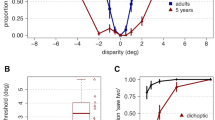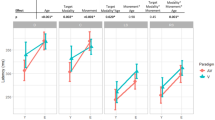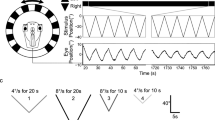Summary
Slow phase horizontal eye movements, elicited by the vestibulo-ocular reflex (VOR) and/or visual pursuit (VP) systems, were examined in normal children (NC, 9–16 years) and normal adults (NA). At slow frequencies of sinusoidal stimulation of the body (with the head immobilized) and/or of a visual target, the NC (9–12 years) exhibited (a) immature VP and VOR Suppression and mature VOR Enhancement in the presence of a visual image; (b) immature VOR Suppression and mature VOR Enhancement in the presence of a non-visual image of the spatial location of a visual target, an extra-retinal signal; (c) inability to augment or depress the VOR gain with a non-visual image; (d) mature VOR Suppression ratios; and (e) adjustment of VOR gain to a high value. The maturational process was featured by (a) parallel development of VP and VOR Suppression; (b) modification of the VOR gain; and (c) an increasing ability to augment or depress the VOR with a non-visual image. The observations in NC (9–12) are ascribed to a maturational lag of an extra-retinal process interacting with mature retinal and vestibular processes and, hence, suggest that both the retinal and vestibular contributions to ocular stability predate the development of an extra-retinal signal. When mature, the central nervous system utilizes both extra-retinal and retinal signals to mediate adaptive regulation of VOR gain and to preserve stable visual pursuit motion and VOR Suppression. Our findings also suggest that during tasks requiring visual-vestibular interaction, VP and VOR mechanisms appear to be indirectly rather than directly coupled.
Similar content being viewed by others
References
Aislin RN (1981) Development of smooth pursuit in human infants. In: Fisher DF, Monty RA, Senders JW (eds) Eye movements: Cognition and visual perception. Erlbaum Press, Hillsdale, New Jersey, pp 31–51
Baloh RW, Honrubia V (1979) Clinical neurophysiology of the vestibular system. Davis, Philadelphia
Baloh RW, Konrad HR, Honrubia V (1975) Vestibulo-ocular function in patients with cerebellar atrophy. Neurology (Minneap) 25: 160–169
Barr CC, Schultheis W, Robinson DA (1976) Voluntary, nonvisual control of the human vestibulo-ocular reflex. Acta Otolaryngol (Stockh) 81: 365–375
Benson AJ (1970) Interactions between semicircular canals and gravireceptors. In: Busby DE (ed) Recent advances in aerospace medicine. Reidel, Dordrecht, pp 249–261
Benson AJ (1972) Effect of angular oscillation in yaw on vision. Proc Aerospace Med Assoc Annu Meet, pp 42–44
Clark DL, Kreutzberg JR, Chee K (1977) Vestibular stimulation influence on motor development in infants. Science 196: 1228–1229
Collewijn H (1979) The modifiability of the adult vestibulo-ocular reflex. Trends Neurosci 2: 98–102
Collins WE (1962) Effects of mental set upon vestibular nystagmus. J Exp Psychol 63: 191–202
Dichgans J, von Reutern GM, Rommelt U (1978) Impaired suppression of vestibular nystagmus by fixation in cerebellar and noncerebellar patients. Arch Psychiatr Nervenkr 226: 183–199
Edwards AL (1972) Experimental design in psychological research. Holt Rinehart Winston, New York
Eviatar L, Eviatar A, Naray I (1974) Maturation of neurovestibular responses in infants. Dev Med Child Neurol 16: 435–446
Eviatar L, Miranda S, Eviatar A, Freeman K, Borkowski M (1979) Development of nystagmus in responses to vestibular stimulation in infants. Ann Neurol 5: 508–514
Fuchs AF, Kimm J (1975) Unit activity in vestibular nucleus of the alert monkey during horizontal angular acceleration and eye movement. J Neurophysiol 38: 1140–1161
Gauthier GM, Robinson DA (1975) Adaptation of the human vestibulo-ocular reflex to magnifying lenses. Brain Res 92: 331–335
Gonshor A, Melvill Jones G (1976) Extreme vestibulo-ocular adaptation induced by prolonged optical reversal of vision. J Physiol (Lond) 256: 381–414
Herman R, Herman R, Maulucci R (1981) Visually triggered eye-arm movements in man. Exp Brain Res 42: 392–398
Ito M (1972) Neural design of the cerebellar motor control system. Brain Res 40: 81–84
Keller EL, Daniels PD (1975) Oculomotor related interactions of vestibular and visual stimulation in vestibular nucleus cells in alert monkey. Exp Neurol 46: 187–198
Keller EL, Kamath BY (1975) Characteristics of head rotation and eye movement — related neurons in alert monkey vestibular nucleus. Brain Res 100: 182–187
King WM, Lisberger SG, Fuchs AF (1976) Responses of fibers in medial longitudinal fasciculus (MLF) of alert monkeys during horizontal and vertical conjugate eye movements evoked by vestibular or visual stimuli. J Neurophysiol 39: 1135–1149
Kornhuber HH (1974) The vestibular system and the general motor system. In: Kornhuber HH (ed) Vestibular system. Springer, Berlin Heidelberg New York (Handbook of sensory physiology, vol VI/2, pp 581–620)
Kremenitzer JP, Vaughan HG, Kurtzberg D, Dowling K (1979) Smooth-pursuit eye movements in the newborn infant. Child Dev 50: 442–448
Lee DN, Aronson E (1974) Visual propioceptive control of standing in human infants. Percept Psychophys 15: 529–532
Lisberger SG, Fuchs AF (1974) Response of flocculus purkinje cells to adequate vestibular stimulation in alert monkey: Fixation vs. compensatory eye movements. Brain Res 69: 347–353
Lisberger SG, Fuchs AF (1978) Role of primate flocculus during rapid behavioral modification of vestibulo-ocular reflex. 1. Purkinje cell activity during visually guided horizontal smooth-pursuit eye movements and passive head rotation. J Neurophysiol 41: 733–763
Lisberger SG, Evinger C, Johanson GW, Fuchs AF (1981) Relationship between eye acceleration and retinal image velocity during foveal smooth pursuit in man and monkey. J Neurophysiol 46: 229–249
Mack A, Fendrich R, Pleune J (1979) Smooth pursuit eye movements: Is perceived motion necessary? Science 203: 1361–1363
Maulucci R, Herman R (1979) Non-visual control of vestibuloocular suppression in man. Soc Neurosci Abstr 5: 692
Meiry JL (1971) Vestibular and proprioceptive stabilization of eye movements. In: Bach-y-Rita P, Collins C, Hyde JE (eds) The control of eye movements. Academic Press, New York London, pp 483–496
Melville Jones G, Milsum JH (1971) Nystagmography: A useful tool in basic and applied investigation. J Physiol (Lond) 219: 191–215
Miles FA (1976) Single unit firing patterns in the vestibular nuclei related to voluntary eye movements in passive body rotation in conscious monkeys. Brain Res 71: 215–224
Miles FA, Eighmy BB (1980) Long-term adaptive changes in primate vestibulo-ocular reflex. I. Behavioral observations. J Neurophysiol 43: 1406–1425
Miles FA, Fuller JH (1975) Visual tracking and the primate flocculus. Science 189: 1000–1002
Miles FA, Fuller JH, Braitman DJ, Dow BM (1980) Long-term adaptive changes in primate vestibulo-ocular reflex. III. Electrophysiological observations in flocculus of normal monkeys. J Neurophysiol 43: 1437–1476
Pola J, Robinson DA (1978) Oculomotor signals in medial longitudinal fasciculus of the monkey. J Neurophysiol 41: 245–259
de Quiros JB (1976) Diagnosis of vestibular disorders in the learning disabled. J Learn Disabil 9: 50–58
Rapin I (1974) Hypoactive labyrinths and motor development. Clin Pediatr (Phila) 13: 922–937
Robinson DA (1968) The oculomotor control system: A review. Proc IEEE 56: 1032–1049
Robinson DA (1971) Models of oculomotor organization. In: Bach-y-Rita P, Collins CC, Hyde JE (eds) The control of eye movements. Academic Press, New York London, pp 519–538
Stark L (1968) Neurological control systems. Plenum Press, New York
Steinberg M, Rendle-Short J (1977) Vestibular dysfunction in young children with minor neurological impairment. Dev Med Child Neurol 19: 639–651
Takemori S (1977) Visual suppression test. Ann Otol Rhinol Laryngol 86: 80–86
Takemori S, Cohen B (1974) Visual suppression of vestibular nystagmus in rhesus monkeys. Brain Res 72: 203–212
Takemori S, Cohen B (1974) Loss of visual suppression of vestibular nystagmus after flocculus lesions. Brain Res 72: 213–224
Uemura T, Cohen B (1972) Vestibular ocular reflexes: Effects of vestibular nuclear lesions. In: Brodai A, Pompeiano O (eds) Basic aspects of central vestibular mechanisms. Prog Brain Res 37: 515–528
Waespe W, Henn V (1977) Neuronal activity in the vestibular nuclei of the alert monkey during vestibular and optokinetic stimulation. Exp Brain Res 27: 523–538
Westheimer G, Blair SM (1973) Oculomotor defects in cerebellectomized monkeys. Invest Opthalmol Vis Sci 12: 618–621
Yasui S, Young LR (1976) Eye movements during after image tracking under sinusoidal and random vestibular stimulation. In: Monty RA, Senders JW (eds) Eye movements and psychological processes. Erlbaum Press, Hillsdale, New Jersey, p 78
Young LR (1977) Pursuit eye movement — what is being pursued? In: Baker R, Berthoz A (eds) Control of gaze in brain stem neurons. Elsevier/North Holland, Amsterdam, pp 29–36
Zee DS, Yee RD, Cogan DG, Robinson DA, Engel WK (1976) Ocular motor abnormalities in hereditary cerebellar ataxia. Brain 99: 207–234
Author information
Authors and Affiliations
Additional information
Supported in part by a grant from the Rehabilitation Services Administration, H.E.W. (23-P555-18/3)
Rights and permissions
About this article
Cite this article
Herman, R., Maulucci, R. & Stuyck, J. Development and plasticity of visual and vestibular generated eye movements. Exp Brain Res 47, 69–78 (1982). https://doi.org/10.1007/BF00235888
Received:
Issue Date:
DOI: https://doi.org/10.1007/BF00235888




